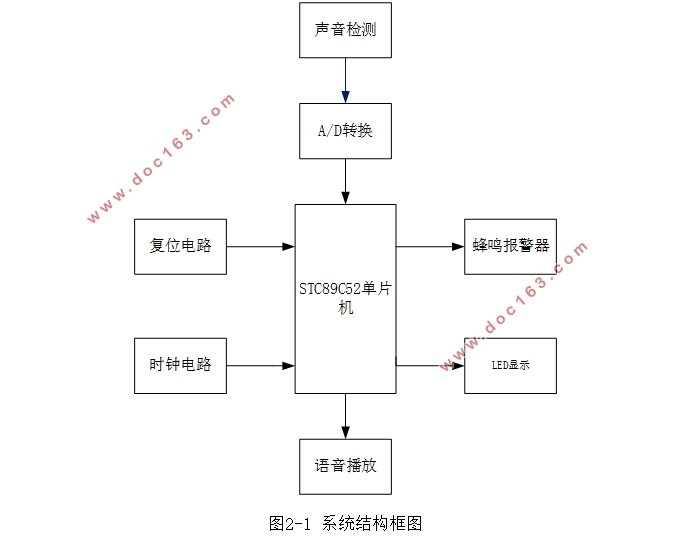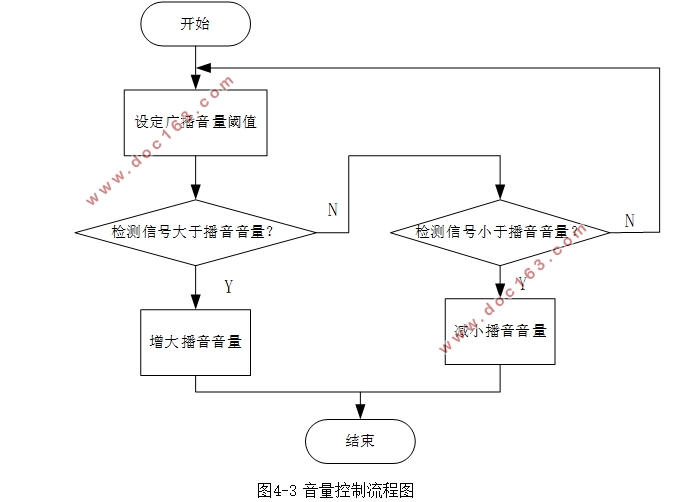广播音量自适应控制系统的设计

广播音量自适应控制系统的设计(论文11000字)
摘要:为了使大厅内广播信息清晰并提高旅客听觉上的舒适度,设计了广播音量自适应控制系统。本系统的控制核心采用 STC89C52 单片机,包含声音采集模块、模数转换模块、语音播放模块、报警模块以及广播音量显示模块。声音检测模块检测大厅内的音量,经过放大、整流、滤波处理之后通过模数转换芯片将声音模拟信号转换成数字信号传给单片机,单片机比较声音检测模块传来的信号与单片机之前设定的广播音量的阈值,根据比较的结果控制语音播放模块改变播音音量的大小。改变后的广播音量存入单片机作为新的阈值,以便与下一次由声音检测模块传来的声音信号做比较,由此实现了复杂多变噪声环境下音量自适应控制。该系统硬软件设计较为简单,容易实现,成本节俭,具有良好的市场前景和推广价值。
关键词:声音检测;音量自适应控制;单片机
Broadcast volume adaptive control system
Abstract: in order to make the broadcast information in the hall clear and improve the comfort level of passengers, the adaptive control system of broadcast volume was designed. The control core of the system is STC89C52 single chip microcomputer, including sound acquisition module, analog to digital conversion module, voice playback module, alarm module and broadcast volume display module. Sound detection module detects the volume of the hall, after amplification, rectifier, filter processing by modulus conversion chip converts voice analog signals into digital signals to single chip microcomputer, single chip microcomputer is sound signals coming detection module and microcontroller before setting threshold value of air volume, according to the result of comparison play voice control module to change the size of the air volume. The changed broadcast volume is saved into the single chip microcomputer as a new threshold value, so as to compare with the next sound signal from the sound detection module, thus realizing the volume adaptive control in the complex and variable noise environment. The hardware and software design of the system is simple, easy to implement, cost saving, with good market prospects and promotion value.
[来源:http://www.doc163.com]
Keywords: sound detection; Adaptive volume control; Single chip microcomputer
[资料来源:http://Doc163.com]


目 录
1绪论 1
1.1 研究意义 1
1.2 研究现状 1
1.3 研究内容 2
2 总体方案设计 3
3 硬件设计 3
3.1 单片机 3
3.1.1 单片机的选择 4
3.1.2 时钟电路 5
3.1.3 复位电路 6
3.2 音量采集模块 7
3.2.1 声音采集芯片 7 [资料来源:Doc163.com]
3.2.2 A/D 转换芯片 7
3.3 语音播放模块 7
3.3.1 语音芯片简介 8
3.3.2 与单片机的连接 8
3.4 显示电路 10
3.4.1 显示器概述 10
3.4.2 显示器与单片机的连接 11
3.5 报警模块 11
4 软件设计 12
4.1 主程序设计 12
4.2 声音检测子程序设计 15
4.3 音量控制子程序设计 16
4.4 显示子程序设计 18
4.5 报警子程序设计 18
5 系统实现 19
5.1 硬件实现 19
5.1.1 原理图的绘制 20
5.1.2 电路焊接 20
5.2 软件实现 22
5.2.1 软件调试工具 22
5.2.2 软件调试方法 22 [资料来源:http://Doc163.com]
5.3 调试运行 23
5.3.1 程序的烧录 23
5.3.2 实物运行步骤 24
6 总结与展望 26
参考文献: 27
致谢 28 [资料来源:Doc163.com]
